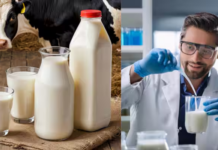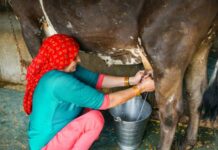The Associated Chambers of Commerce and Industry of India (ASSOCHAM) urged the Bharatiya Janata Party- (BJP) led Uttar Pradesh government to formulate a suitable strategy to unlock the significant growth potential of the dairy sector in the state through productivity enhancement, strengthening and expanding village-level infrastructure for milk procurement and providing producers with greater access to markets.
“With 26 million tonnes (MT) of milk production, Uttar Pradesh was ranked on top with 17 per cent in India’s total milk production of over 155 MT as of 2015-16,” noted an analysis of the National Dairy Development Board (NDDB) statistics conducted by ASSOCHAM Economic Research Bureau (AERB).
“However, despite commanding the highest share in India’s total milk production, the state registered a meagre 4.7 per cent annual growth in this regard between 2014-15 and 2015-16,” highlighted the ASSOCHAM sector-specific analysis.
Milk production across India clocked over six per cent annual growth during the period.
While the number of registered units manufacturing dairy products in India increased by 26 per cent between 2010-11 and 2013-14, the number of such units in Uttar Pradesh declined by five per cent during the period.
However, the total output of dairy products manufactured by these units has increased by about 87 per cent and 96 per cent in India and in Uttar Pradesh, respectively.
The number of people engaged in these dairy product manufacturing units have also increased considerably by about 29.5 per cent and 42 per cent in India and Uttar Pradesh, respectively.
“The dairy sector can play an important role in providing jobs for rural communities, as dairy production and processing provide employment, not only to people who work on dairy farms or in dairy plants, but also to the whole sector, from upstream inputs and services providers to downstream marketing of finished products,” said D S Rawat, national secretary general, ASSOCHAM, releasing the findings of the chamber’s analysis.
“Dairying is an important secondary source of income for many of rural families and has assumed the most important role in providing employment and income-generating opportunities, particularly for marginal farmers and women,” he added.
“There is a need to recognise the importance of small farm dairy units and opportunities for value chain development, which can lead to poverty reduction and rural development in Uttar Pradesh,” Rawat said.
“Dairy sector development can be a powerful tool for reducing poverty and creating wealth in the state,” he added.
ASSOCHAM’s analysis further highlighted that Jammu and Kashmir (16.5 per cent), Madhya Pradesh (about 13 per cent) and Andhra Pradesh (12 per cent) were the top states in terms of annual growth in milk production.
It also noted that after Uttar Pradesh, it was the states of Rajasthan (12 per cent), Gujarat and Madhya Pradesh (about eight per cent each) that had the maximum share in milk production across India.
With the growth of the economy, a shift is seen from the regular diet of cereals to a more varied and nutritious diet of fruits and vegetables, milk, fish, meat and poultry products. All these aspects further highlight the need to build up a robust production as well as supply chain network of milk products.
“Thus, the domestic dairy market must become increasingly responsive to market signals and changing consumer preferences,” the analysis noted.
For higher price realisation, one needs to graduate from simple, low-value commodities to high-value added processed products. Marketing holds the key to ensuring that products are available at the right place, at the right time, at the right price. Brand building is an essential exercise for all dairy companies to exploit the full potential of the dairy value chain. Some of the processed tradable dairy products comprise condensed milk, cheese, dry milk products and butter or ghee.
The following are certain suggestions to the government of Uttar Pradesh to formulate a long-term strategy for the state’s dairy industry:
- Promoting dairy entrepreneurship
- Promoting application of new technologies for higher productivity
- Strengthening economic viability of dairy farms
- Increasing the link between rural production areas and urban markets
- Developing packaging in small quantities to meet the needs of the poor
Milk production by states (in ‘000 tonnes)
|
State |
2010-11 |
2011-12 |
2012-13 |
2013-14 |
2014-15 |
2015-16 |
Share in All India 2015-16 |
Annual Growth |
|
|
Uttar Pradesh |
21,031 |
22,556 |
23,330 |
24,194 |
25,198 |
26,387 |
17 |
4.7 |
|
|
Rajasthan |
13,234 |
13,512 |
13,946 |
14,573 |
16,934 |
18,500 |
11.9 |
9.2 |
|
|
Gujarat |
9,321 |
9,817 |
10,315 |
11,112 |
11,691 |
12,262 |
7.9 |
4.9 |
|
|
Madhya Pradesh |
7,514 |
8,149 |
8,838 |
9,599 |
10,779 |
12,148 |
7.8 |
12.7 |
|
|
Andhra Pradesh |
11,203 |
12,088 |
12,773 |
13,007 |
9,656 |
10,817 |
7 |
12 |
|
|
Punjab |
9,423 |
9,551 |
9,714 |
10,011 |
10,351 |
10,774 |
6.9 |
4.1 |
|
|
Maharashtra |
8,044 |
8,469 |
8,734 |
9,089 |
9,542 |
10,153 |
6.5 |
6.4 |
|
|
Haryana |
6,267 |
6,661 |
7,040 |
7,442 |
7,901 |
8,381 |
5.4 |
6.1 |
|
|
Bihar |
6,517 |
6,643 |
6,844 |
7,197 |
7,775 |
8,288 |
5.3 |
6.6 |
|
|
Tamil Nadu |
6,831 |
6,968 |
7,005 |
7,049 |
7,132 |
7,244 |
4.7 |
1.6 |
|
|
Karnataka |
5,114 |
5,447 |
5,718 |
5,997 |
6,121 |
6,344 |
4.1 |
3.6 |
|
|
West Bengal |
4,471 |
4,672 |
4,859 |
4,906 |
4,961 |
5,038 |
3.2 |
1.6 |
|
|
Telangana |
– |
– |
– |
– |
4,207 |
4,442 |
2.9 |
5.6 |
|
|
Kerala |
2,645 |
2,716 |
2,791 |
2,655 |
|||||
































